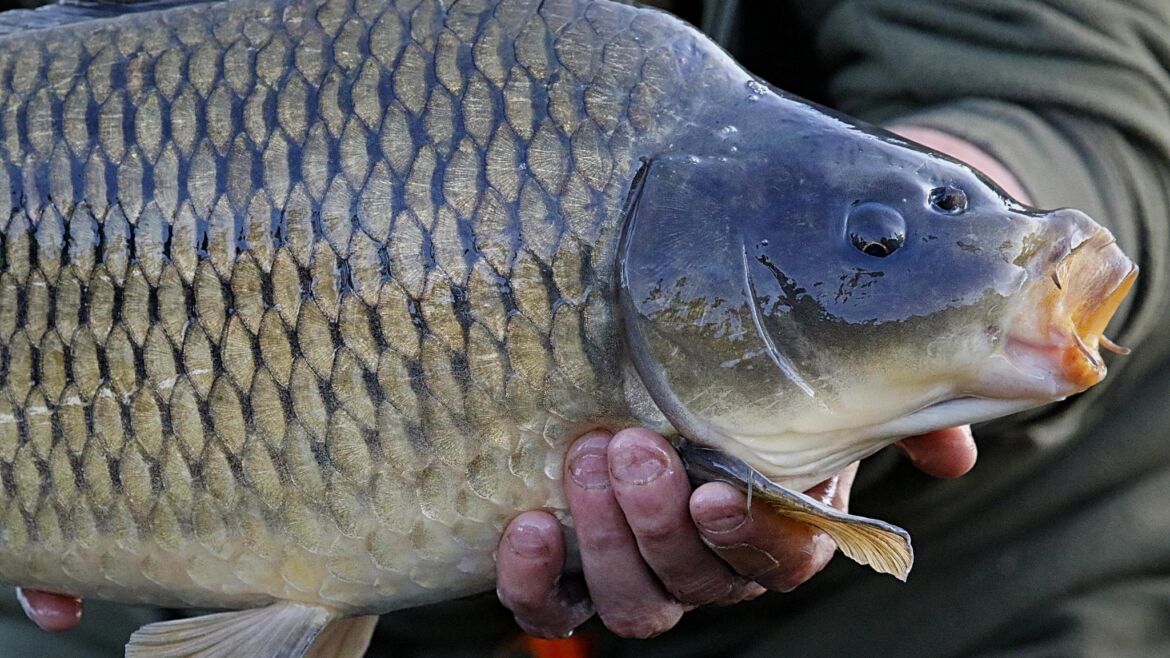As one of the fastest-growing angling sports in the United States, carp fishing is taking off with young and old anglers alike. Introducing young anglers to carp fishing is a great way to show them the true strength and fight of these hard-hitting fish. Carp are a hard-striking and fighting fish, often found in challenging environments, which makes landing a big carp quite a challenge even for experienced anglers who are used to tangling with these wily fish.
This is not to be confused with other invasive species, such as the Asian Carp, common carp, and Cyprinus carpio, which are found throughout American freshwater lakes and rivers. Carp were originally bought over by European settlers as a food source and later restocked by the government throughout the 1870s and 1890s. You’ll now find carp in almost every river and lake in every state.
Although carp are highly regarded in almost every country in the world for not only their eating quality but also their hard fight, carp have, rightly or wrongly, earned a bad reputation among many American anglers. However, that reputation is slowly being turned around, and carp are currently experiencing a resurgence. Pound for pound, carp are easily one of the hardest and most cunning freshwater fish in the world.
In the following guide to carp fishing, we’ll cover:
If you’re just getting started in the world of angling and still learning the ins and outs of fishing, be sure to check out Best Barometric Pressure for Fishing: Ultimate Guide! It covers everything you need to know about how barometric pressure and weather patterns affect fish behavior.
When it comes to carp fishing, particularly in water that you’re unfamiliar with, such as finding the best local hot spots, Fishbox App, a premium app for fishing, could be perfect for you! Thanks to the Fishbox App, you’ll know the best time to chase those big carp and when you’re better off relaxing at home and getting your fishing tackle or boat ready for your next angling adventure.
Get your personalized fishing map
Answer a quick quiz and get your own personalized fishing map
Expert Opinion on How to Catch Carp
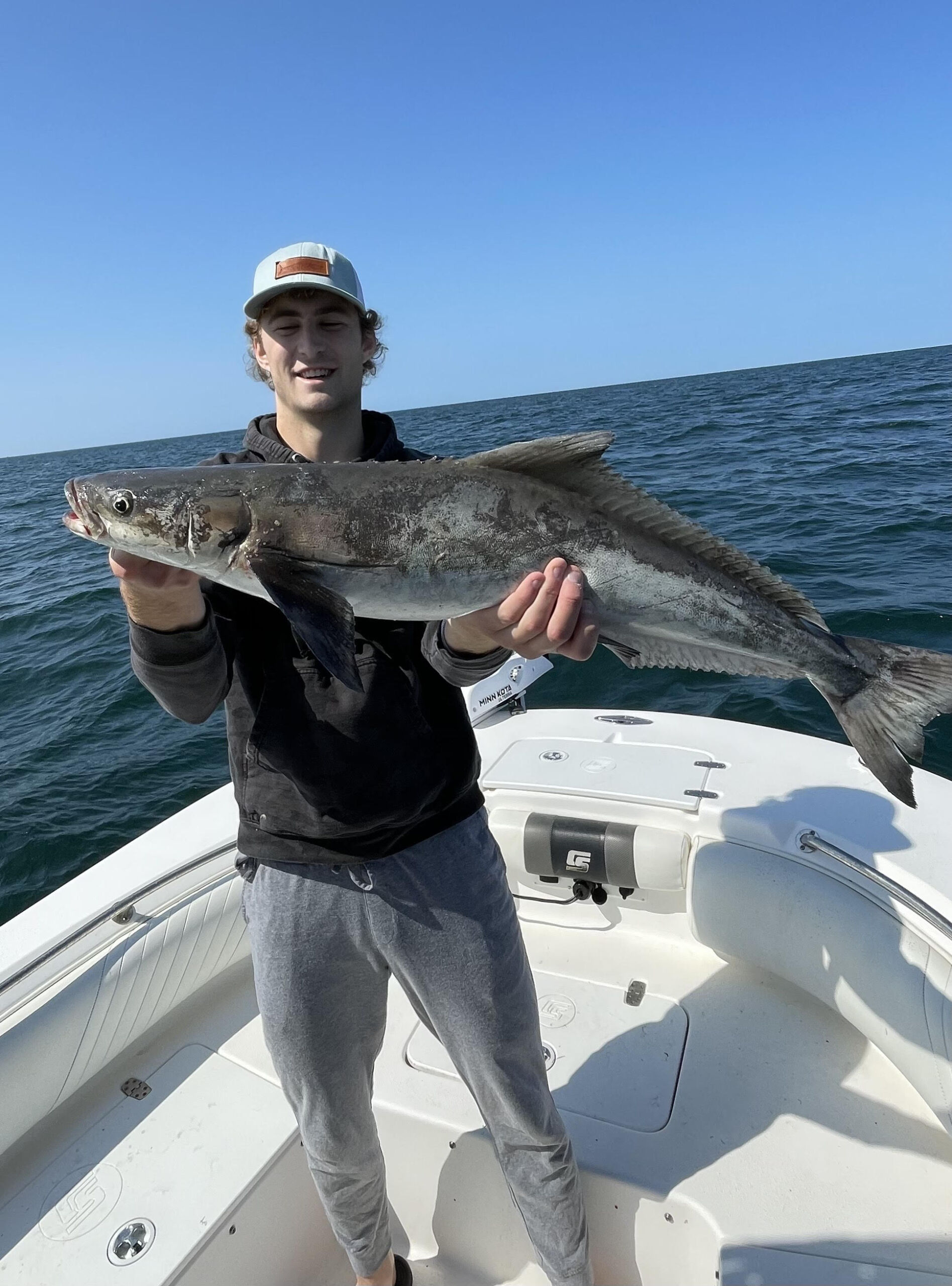
Pierce Latta
16 years fishing experience
“While carp fishing has always been very popular in Europe, it is beginning to grow in popularity here in the United States. In my fishing career, I have caught a ton of carp ranging from as small as five pounds to as big as thirty to forty pounds. Carp may not offer the greatest table fare, but they do often put up an excellent fight and can grow to monster sizes. Additionally, carp can be found all over the states in a ton of local ponds and lakes.
Once we get past the introduction, one of the first sections we get is a discussion on understanding carp and their behavior. I love how every article starts with this. It’s not just about throwing whatever bait we can at a carp. Instead, we have to see and understand what the carp want in order to give us a better chance of catching them.
One of the things I love about this section is how it describes the variety of species. There are so many different kinds of carp spread all throughout the country—some even sharing the same bodies of water.
In the next section, we get a brief look into the feeding patterns of carp and what they typically eat. This was super cool to read about because I honestly had no clue what carp eat in the wild. In the next section, we discuss how carp fishing varies around the year.
From my experience with carp fishing, I completely agree with the article. Carp are far more active and present in the warmer months and also way more willing to eat. Not only do I rarely see or encounter them in the winter months, but I have gotten very few bites in my time fishing for them.
With regards to the gear “required” for carp fishing, I honestly disagree with some of what is recommended.
Carp can absolutely get very big, but you never need a 10–12-foot rod. In most cases, I’m fishing in ponds for carp, and I simply don’t have the space to use that big of a rod. I honestly prefer a 7-foot rod that has a little but more backbone to it.
Moreover, I would never suggest using a line as light as 8-10 pounds. In my experience, that is just too light of a line. I’ve caught 30-pound carp, and I really wouldn’t want to test my patience with an 8-pound line. I prefer to use at least a 20-pound line.
These are really the only critiques I have of the entire article.
Following the gear section, we get a couple of sections about the location of the carp. I
n my experience, your best bet for carp fishing is going to be in smaller ponds. Carp are often easier to find and thus catch than larger bodies of water.
Additionally, while the tactics and other information in this article are great, I would urge you to listen to one of my usual tactics.
If I know there are carp in the body of water, I will often bring bread. I will start chucking out balls and pieces of bread to see if the carp are willing to feed. If they are, I would use a smaller hook and barely hook it in a piece of bread so that it can float on the top. Try and cast it out as far as possible and wait for the carp to come up and slurp it down. This is just one tactic I would encourage you to consider especially if you see carp on the top of the water feeding.
I hope you have enjoyed reading this article and these comments and as always, good luck and tight lines.”
Visit his Instagram profile.
Subscribe to his YouTube channel.
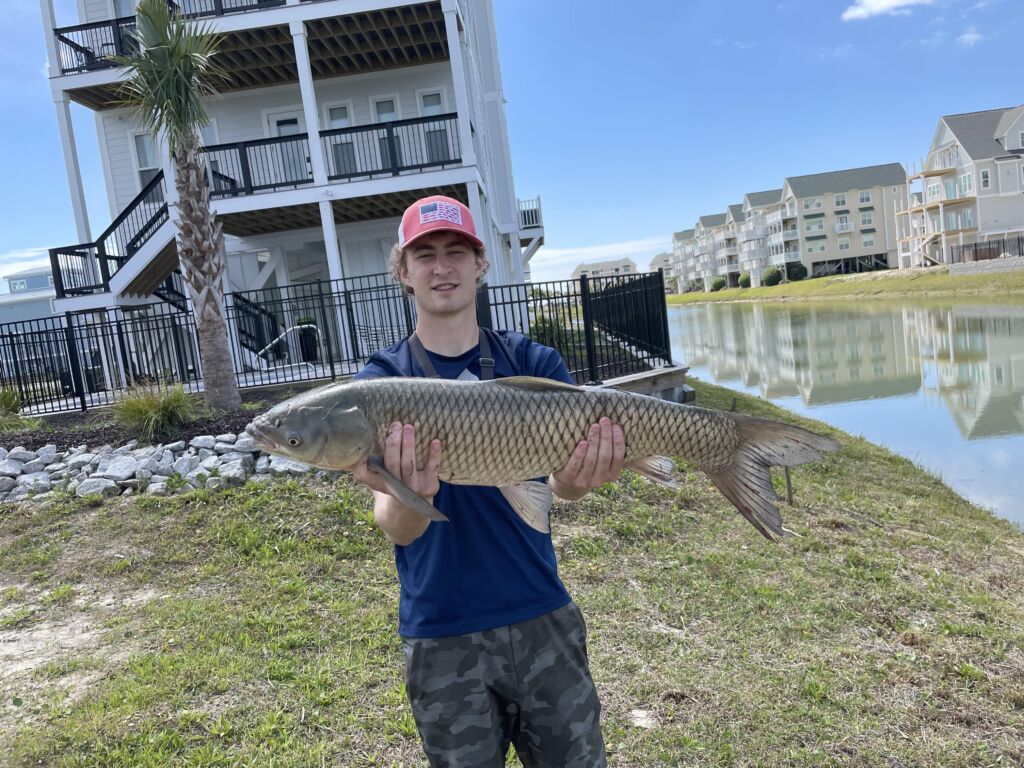
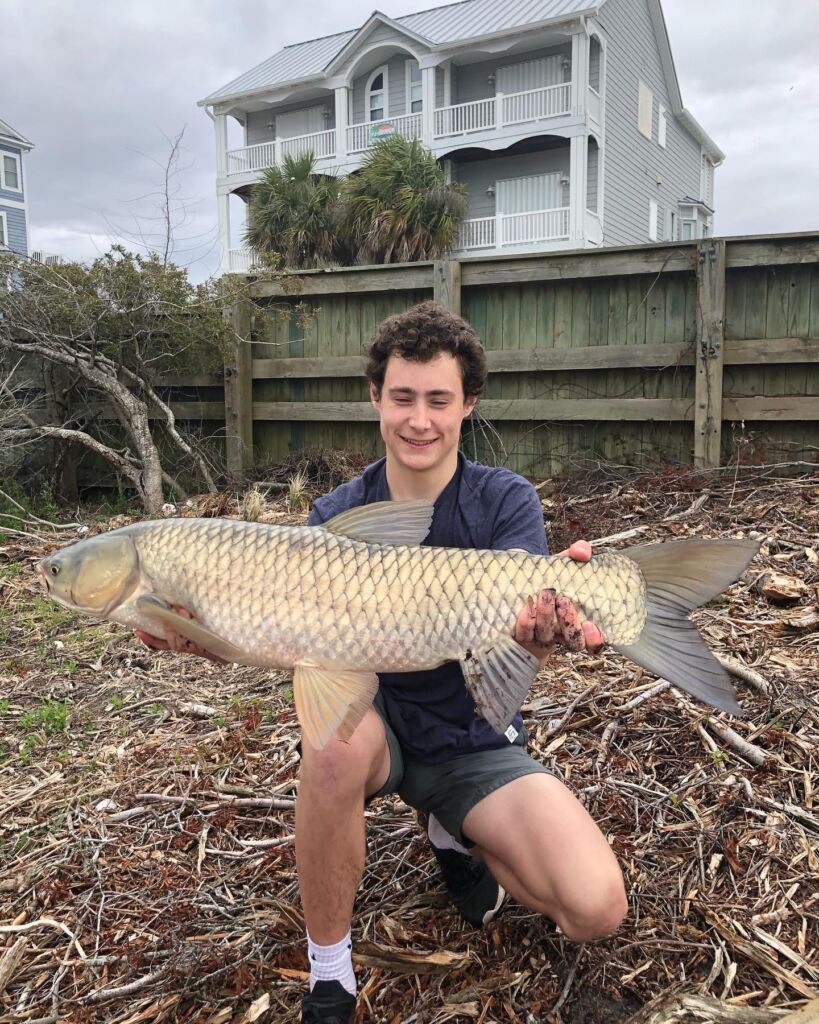
Understanding Carp
Carp, a large bottom-feeding fish, are a hardy fish able to survive in almost any freshwater conditions, which is why they’ve spread so much across the United States. You’ll commonly find carp in ponds, streams, rivers, and lakes in almost every water condition, from clear water to cloudy.
The carp, related directly to the common goldfish you might find in a home aquarium, has a large, rounded body, forked tail, elongated dorsal fin, and barbels located around its mouth. Depending on what species of carp and the environment they’re living in, carp can be found in a variety of colors ranging from bright gold to dark, deep green.
Although carp have been known to reach 20-23 lbs, with some even getting up to the vast 60 lb. range, most are caught around the 10-15 lb. range and measure in at about 30 inches long.
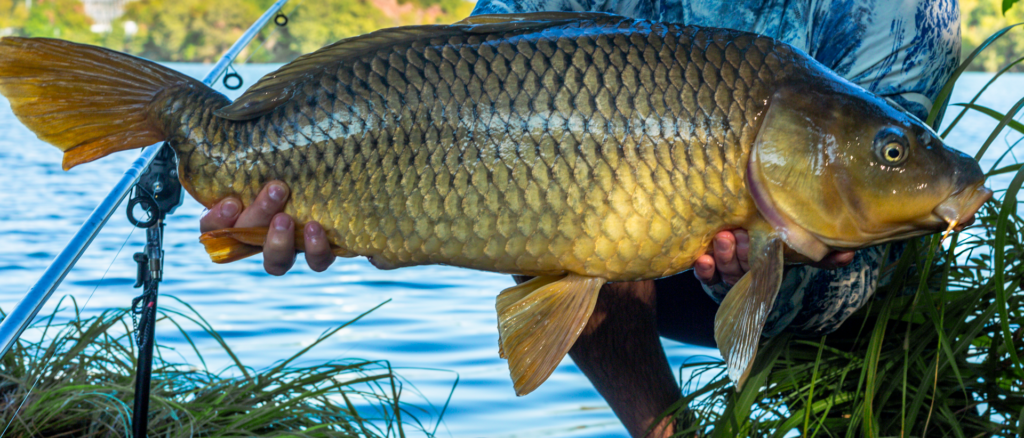
While the common carp has been in the United States for almost 200 years, there are also a variety of recent invasive species of carp which have caused issues for anglers. Bighead carp, grass carp, black carp, and silver carp were all introduced accidentally after being imported from Asia.
In areas such as the Mississippi River and surrounding waters, these invasive species of carp are causing huge issues because of their prolific breeding, fast-growing, and aggressive feeding nature, which not only leaves a lot of environmental damage but also heavily outfeeds native fish in their area.
Bighead carp, grass carp, black carp, and silver carp were all introduced into the United States for use in aquaculture ponds where it was intended that they would help control algae blooms in contained ponds and pens. However, accidental releases, mishandling, and naturally occurring weather events such as flooding caused the carp to find their way into the most extensive freshwater highway in the United States, the majestic Mississippi River system, and, from there, a variety of streams and rivers.
The more you understand about carp, the easier it’s going to be to find them and ultimately catch them. With carp being widely underfished by most American anglers, you should be able to find some excellent carp fishing in your local area.
Carp Are Hungry Feeders
It’s important to understand that carp are never far from a food source. If you can find an excellent food source, the carp won’t be far away. Carp feed mostly on shrimps, bugs, snails, and larvae, with larger carp eating clams, mussels, crayfish, and small fish.
When you find natural areas that are abundant with these food sources, it’s an excellent place to start. Try to spot clear patches of bottom amongst weeds and gravel, which could be high carp traffic and congregation areas. As opportunistic feeders, look for spots where people feed ducks, as carp love to hang around these areas to pick up scraps.
The Best Time to Catch Carp
Carp like to visit shallower water during the winter as the warmth from the sun heats the water and they love to bask in warmer waters. Even during the warmer summer months, they can be found basking in the sun, but typically close to deep water where they can escape to safety should they feel threatened.
Other areas that are worth trying include natural and artificial structures. If you find an area that looks like it would support catfish, there’s a good chance that you could find carp there, too.
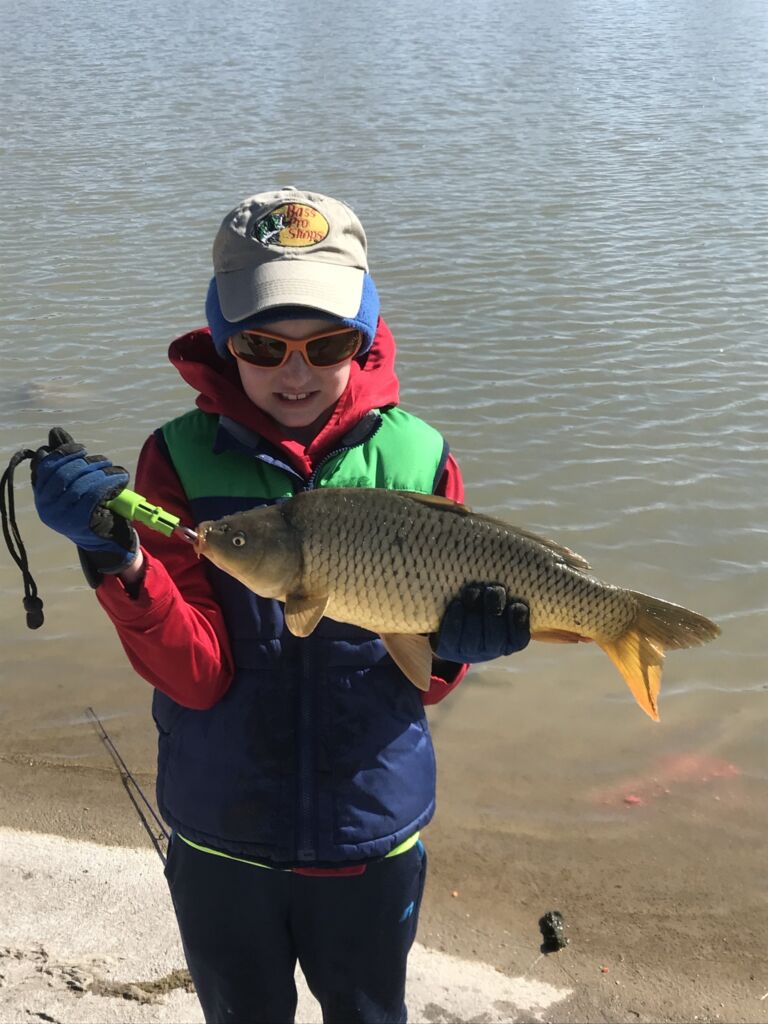
Although you can catch carp year-round in most locations, they do have a slow metabolism compared to other fish species, which means that it’s going to be more difficult in the cold winter months.
Prime carp angling times include early mornings, early evenings, and throughout the night. However, if you’re patient enough, you’ll still be able to catch them during the day. Carp are a lot more confident feeding during darkness, so they tend to take more risk and feed more aggressively than they would during the brighter daylight hours.
Essential Gear for Carp Fishing
Although you can use any fishing tackle to catch carp, a slightly longer rod, which is better suited to float fishing from the bank, is a good choice as it will allow you to have a little more room to maneuver when you are fighting larger fish and give you more distance when casting.
For young anglers, 8-10-foot rods are a good choice, with a 12-foot rod being suitable for adult anglers. Most carp anglers recommend going with a size 8-10 hook and 8-10lb line. You can use either a bait caster or a traditional spool reel; it’s up to you, and you shouldn’t need to purchase any specialized reels for carp fishing. However, recently, a lot of anglers have been getting into fly fishing for big carp, sight casting to fish lurking in shallow water.
Most anglers will be able to rig a simple carp rig using hooks and sinkers they already have in their tackle box without the need to purchase new equipment. A simple rig with a sliding sinker positioned so that it can’t touch the bait, along with a float, is an easy way to get out on the water and start landing some monster carp.
European carp fishing rigs and tackle are a lot different for several reasons, including angling pressure, burley or chum being used, and the location where people are predominantly fishing for very big carp.
Read also: How to Fish in a River: Tips and Techniques
Choosing the Right Location
If you want to be an excellent carp angler, you need to know where the carp are. After all, as with all fishing, it’s no use fishing where the fish aren’t!
Because carp are so widespread throughout the United States, you shouldn’t have to travel too far outside of your local area to find some carp angling opportunities. While common carp can be caught in most freshwater locations and in various water conditions, some areas are still better than others.
Areas of water that are slow-moving or standing in lakes and rivers are going to be prime carp locations. When fishing for carp, it’s vital to be patient and avoid touching or moving the line or bait, as carp are excellent at picking up even the most subtle movements.
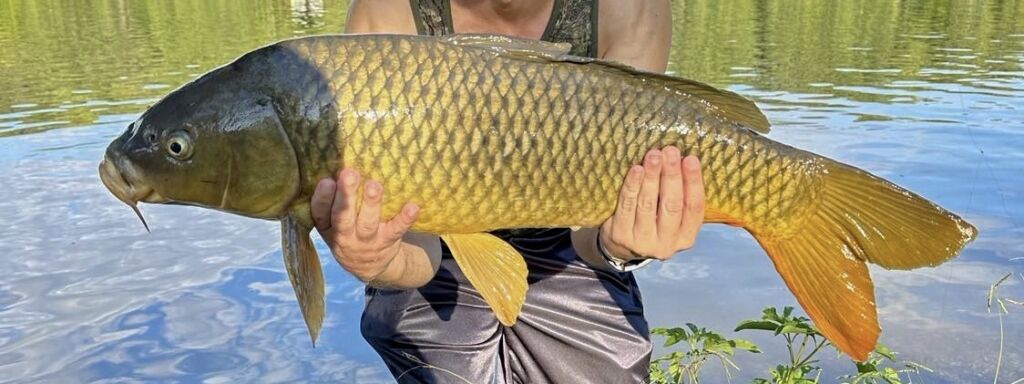
When you arrive at your fishing destination, look for the stillest areas of the lake or river with the least amount of current. Another good sign to look for is cloudy or murky water, as it gives carp more confidence while they’re feeding. They’ll feel safer in the cloudy water compared to clear water, but you will still catch carp in clear water. Side channels, backwaters, and along the shoreline are all great places to focus when carp fishing.
They say that the early bird catches the worm, and it’s true for early anglers targeting carp also! Try early morning, late evening, or into the night to increase your opportunities.
The two primary environments where you’ll catch carp are either rivers or lakes. However, you can find carp in ponds and small streams in some locations.
Catching Carp In A Lake
Catching carp in a lake starts with finding the most likely carp habitat. Like most fish, carp prefer areas with structure, either natural or artificial, where they feel like they have some protection while they feed, so looking for structures is a great place to start.
When you’re walking along the edge of the lake, keep your eye out for any overhanging trees or branches, weed banks, and logs or fallen trees. If there is a particular area of the lake with slower or still water, there’s a good chance that you’ll find some big carp lurking there.
Catching Carp In A River
Catching carp in a river is always going to involve being a little more selective about your target fishing locations, as strong moving currents aren’t a favorite spot for carp to spend their day. You can still use the same rigs and baits, but where you choose to fish in the river has a much more significant impact on your chances of catching a big fish.
Strong currents mean that the carp will need to expend a lot more energy to feed and keep themselves in location underwater. So, finding areas out of the current, such as bends in the river and natural or artificial structures that allow carp to rest and feed without expending as much energy, are great places to start.
Regardless, carp in rivers still need to expend more energy than their cousins living in rivers, which means that they’re going to be feeding more often. River inlets, locations where the river or stream connect with one another, are natural locations for food to congregate, and where there’s food, there’s carp.
Techniques for Catching Carp
Carp Fishing Using the Hair Rig
One rig which is excellent for catching carp is the hair rig. The hair rig, after a lot of discussion and lobbying by the American Carp Society and the International Game Fish Association (IGFA), is now the accepted form of capture for carp globally. Not only does the hair rig increase hook-ups and catch rates, but it also decreases the amount of carp that are foul-hooked, and that’s great for both beginners and experienced anglers.
An added bonus to the hair rig is that once you’ve tied it a few times and got the hang of it, it’s easy to remember and teach to new anglers. Carp have a natural ability to detect unnatural bait and line movement, so you need to always be one step ahead of these wily fish.
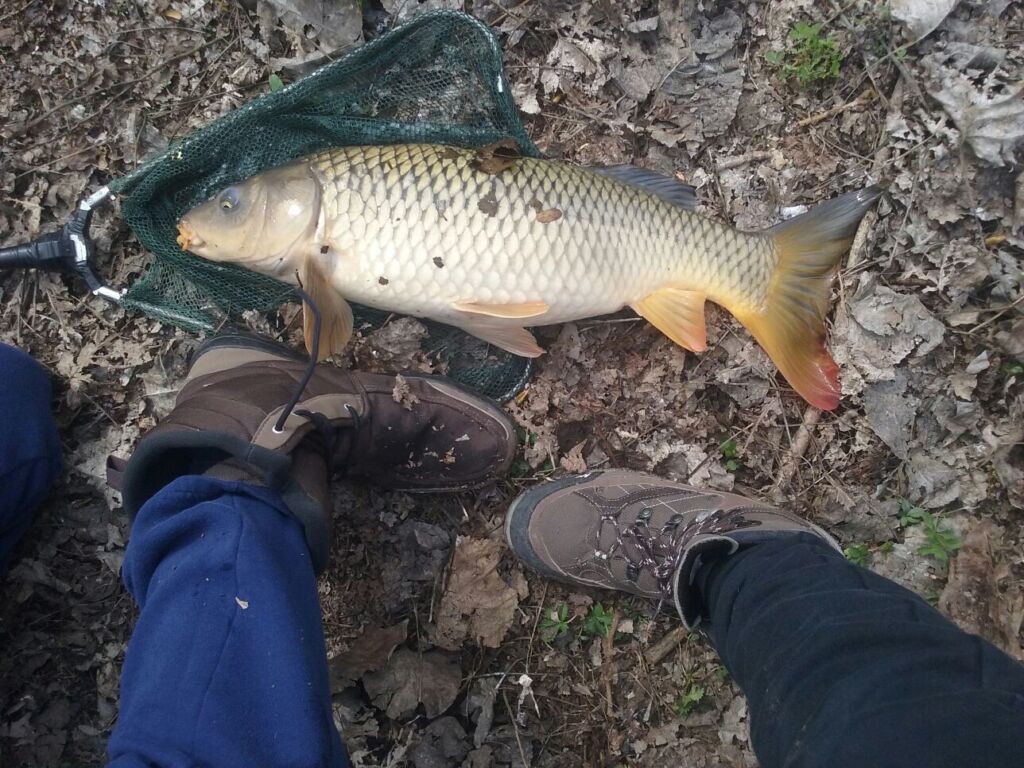
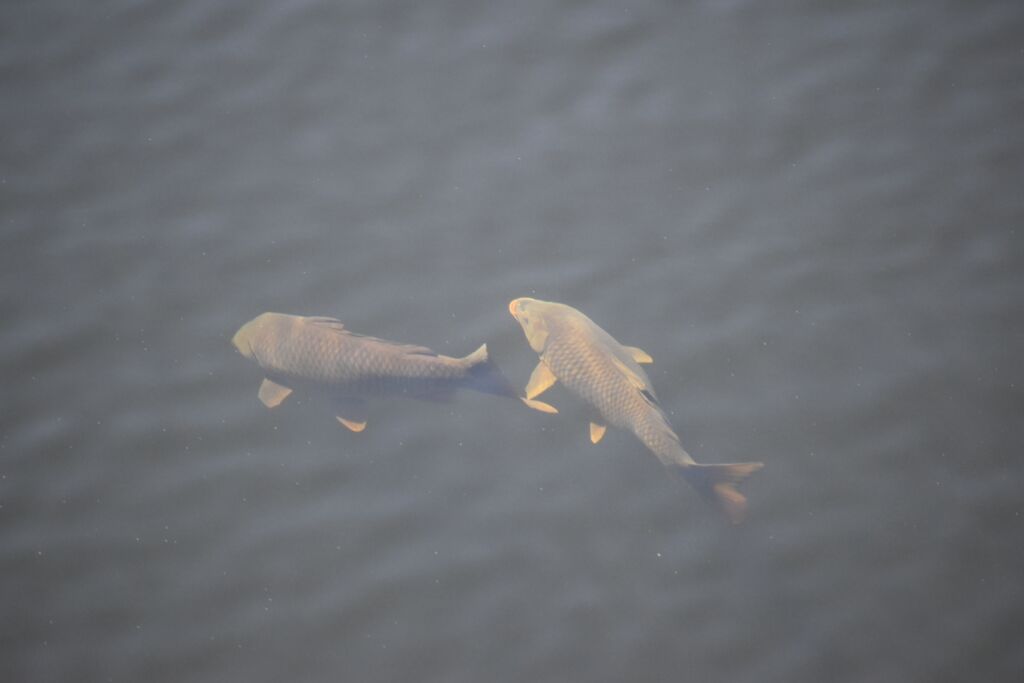
By adding a few grains of corn to the hair rig, you have a deadly combination for catching big carp, either under a float or on the bottom.
The hair rig was designed to allow the free movement of the bait in the water, with the bait not being directly attached to the hook.
- Start by taking 10-12 inches of hook length line and tying a simple loop at the end, ensuring to trim any extra.
- Thread the other end of the line through the hook’s eye, being sure to leave the hair slightly longer than the hook so the bait dangles.
- With the hair held against the shaft of the hook, wrap the line around the hook half a dozen times.
- Holding your wrap tightly, thread the end of the line through the back of the hook eye once again, and then pull tight.
- Now, it’s time to add the bait to the hair. Pre-soaked corn works best, and a specialized baiting hook works best, but you can get away with a skewer or needle.
- Thread the corn onto the hair, 2-3 corn kernels, add a plastic bait stop at the end, trim any extra, and you’re ready to go!
As we mentioned above, corn makes the best carp bait, followed by bread, nightcrawlers, and worms. For larger carp, boiled baits are great to use on hair rigs and have been responsible for some big carp catches.
Best Ways to Catch Carp Quickly
Below are our tips for helping you to catch carp quickly:
- Location – It’s no use fishing where the fish aren’t, and carp are no different, so look for shallow, slow-moving water around the structure but still close to deep water.
- Time – The best times for catching carp are early morning, late afternoon, and into the night. You can still catch carp during the day, but they won’t be feeding as aggressively, so it will be a little more complicated.
- Bait – Carp eat various foods, including fish, eggs, insects, plankton, and river plants. Boiled baits, bread, and corn are also great carp baits.
- Rigs and Hooks – The hair rig we spoke about above is the best method for catching carp, so while you’re tying it, avoid using shiny hooks.
- Rod Holders – Carp are excellent at picking up movement in lines and bait, so avoid touching or moving your rod as much as possible. A rod holder or rod pod is perfect for this.
- Burley or Chum – Where allowed, burley or chum is a great way to lure carp into your area. However, if you can’t chum the water, fishing in areas where people are feeding ducks is also a perfect carp location.
Read also: Melbourne Fishing: Your Comprehensive Guide
How to Catch Carp: A Comprehensive Guide | Conclusion
When it comes to catching carp, by following the information above, including understanding carp behavior, the best gear for carp fishing, techniques, locations, and landing carp in different environments, you’ll be better prepared to land monster carp and take your angling to the next level.
Regardless of where you plan on going carp fishing, even the most experienced anglers need a little, and thanks to the premium fish forecasting application Fishbox, you’ll be in the perfect position to land some excellent fish. The Fishbox App utilizes accurate weather, tide, and fishing conditions to predict the best time to get out on the water to catch your target species.
Get your personalized fishing map
Answer a quick quiz and get your own personalized fishing map
Do you have a lot of experience fishing for carp and have any carp angling tips or tricks that you’d like to share with new anglers? Then, drop a comment below with your carp fishing tips!
